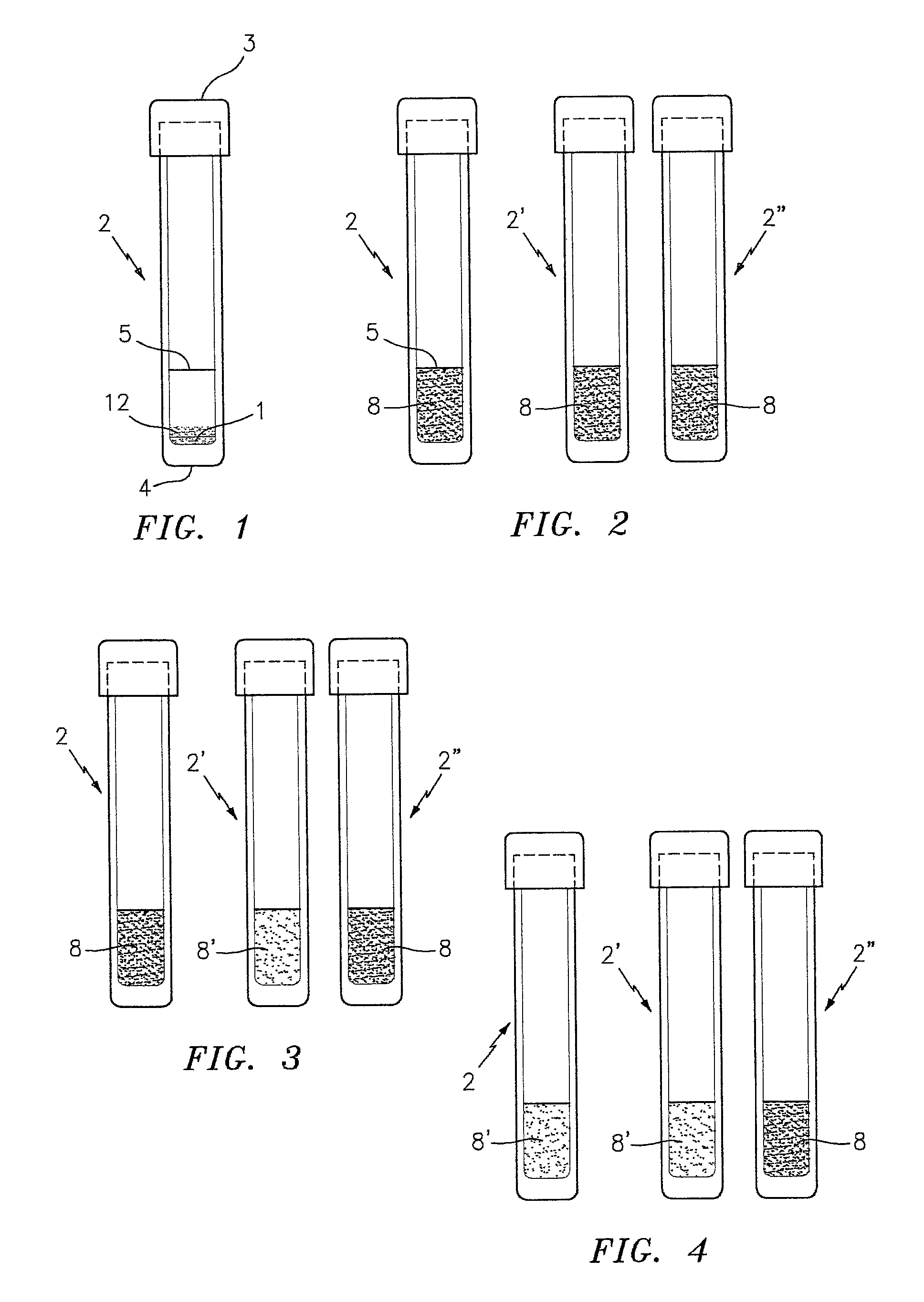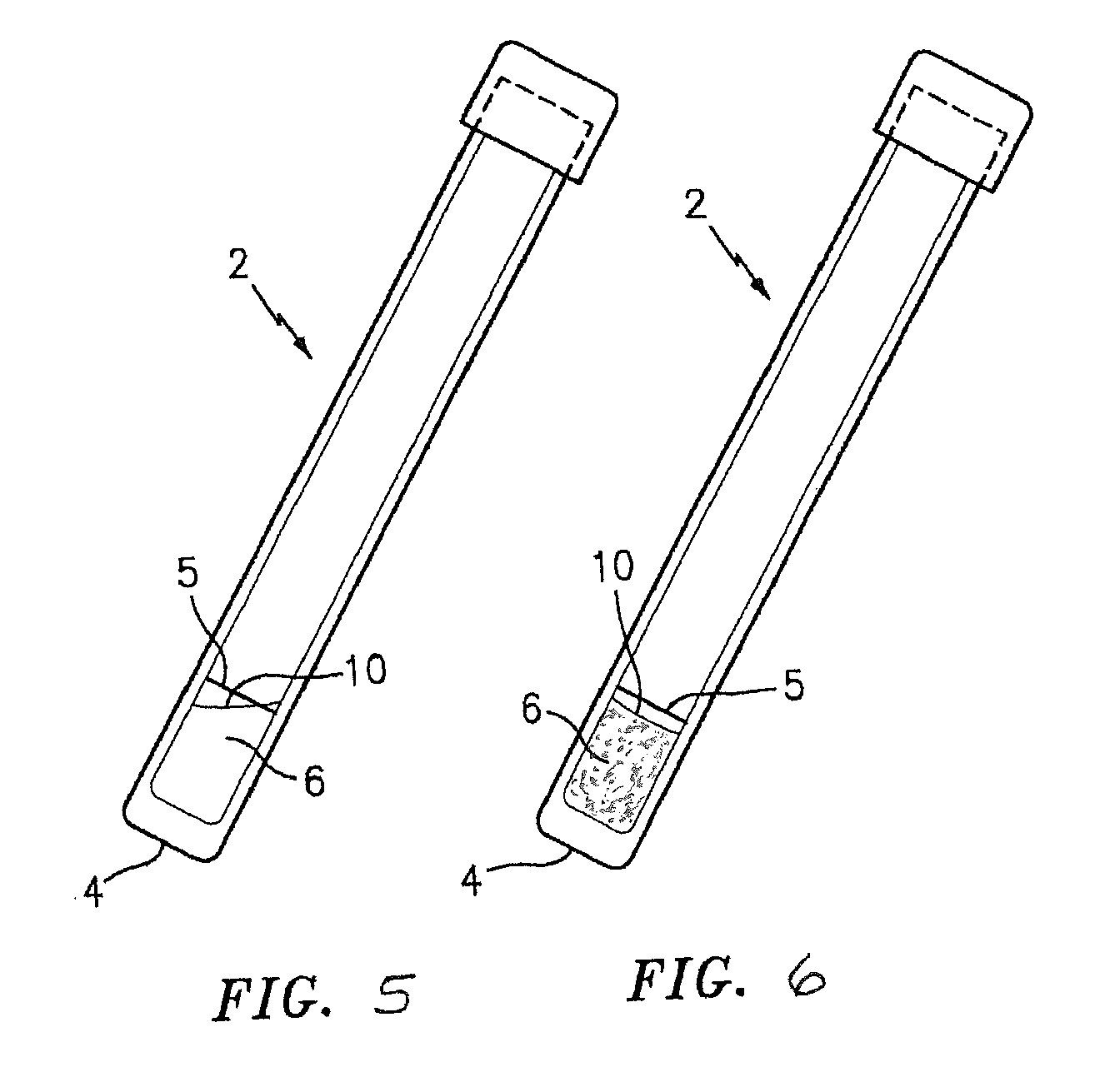[0019]In some embodiments, the present invention utilizes a combination of the above described mediums operable to detect one or more targeted strains of antibiotic resistant P. staphylococci. The combination of the detectable signal and the clot, via the constituents that create those aspects in the presence of a targeted strain of antibiotic resistant P. staphylococci, synergistically produce a test and with increased specificity to the targeted bacteria. The coagulase reaction (i.e., the clot) increases the efficiency of the sensing of the detectable signal. One of the reasons the efficiency is increased is because the solid / quasi-solid matrix (which may be a gel, etc.) formed by the coagulase reaction allows for a more efficient metabolism of the hydrolysable substrates. Another reason the efficiency is increased is because the solid / quasi-solid matrix creates a lowered oxygen tension, which enhances the glycolytic pathway of catabolism (e.g., splits sugars and digests them more efficiently). The containment of the hydrolysable substrates within the clot inhibits the access to oxygen which in turn promotes anaerobic fermentation and consequent product of more detectable colors. The detectable signal will typically be produced within 6 to 8 hours after inoculation of the medium with the sample.
[0020]The present medium is preferably prepared in a form that facilitates handling, packaging, storing, etc., of the medium. A dry powder that can be hydrated into liquid form is a particularly preferable embodiment of the test medium, but the present invention is not limited to a powder form. The medium may assume a liquid form, or any other form (e.g., paste, gel, etc.), preferably one that can be hydrated for use.
[0023]For those embodiments of the present invention operable to produce a clot in the presence of the targeted strain of antibiotic resistant P. staphylococci, the medium further includes coagulase substrates (sometimes referred to as “coagulase reacting factors”), that react specifically with the enzyme coagulase produced by P. staphylococci (e.g., S. aureus) to form a clot. The coagulase substrates within the test mixture may be provided within plasma, or may be provided by another substance that is operative to react with the coagulase produced by S. aureus to form a clot. Present testing indicates that rabbit plasma is a favorable source of a coagulase substrate. Other plasmas (e.g., pork plasma) may be used alternatively. Fibrinogen is another example of a source of a coagulase substrate. Bovine fibrogen is an acceptable type of fibrogen for use in the present invention. In those embodiments that utilize plasma as a source of a coagulase substrate, it may be preferable to add a non-plasma source of a coagulase substrate to the test mixture to ensure an adequate source of coagulase substrate within the test mixture. As an example, our testing indicates that combining fibrinogen and rabbit plasma within the test mixture is an effective means for ensuring a consistent, adequate source of coagulase substrates. An advantage of adding a material such as fibrinogen to the test mixture is that it increases the performance consistency of the test mixture, and makes the method less susceptible to variability that may occur with plasma.
[0025]The hydrolysable substrate includes nutrient molecules which, when metabolized by the targeted strain(s) of antibiotic resistant P. staphylococci produce a detectable signal; e.g., the visible color of the solution (or other detectable signal) containing the specimen is changed as a result of the nutrient being metabolized by the target bacteria. For example, the hydrolysable substrate can include a natural sugar (e.g., mannitol, trehalose, etc.) having one or more monosaccarides joined with an indicator moiety that does not produce a detectable signal when joined with the natural sugar. When the nutrient is metabolized by the target bacteria and the bond between the nutrient and the indicator moiety is broken, the indicator moiety produces a sensible signal (e.g., becomes colored—visible yellow). In those embodiments wherein the indicator moiety is operable to produce a color change, the indicator moiety can produce color in the visible range, ultraviolet range, or the infrared range, although color in the visible range facilitates test analysis in many cases.
[0028]The test medium may be packaged in a container (e.g., a test tube, a container with a flat bottom wall, etc.) that facilitates the testing process. If the medium is prepared in a form that can be hydrated, the mixture can be hydrated with sterile water or non-sterile water.
[0031]The present invention testing medium and method can be used in hospital admissions, routinely in intensive care units, in nursing homes, dialysis patients, people receiving home immunosuppressive therapy, and the like. It can also be used in environmental settings (e.g., gyms, tanning salons, restaurants, etc.) where the P. staphylococci may be transferred from a human carrier and it can be used to test various different foods for P. staphylococci contamination. It will be appreciated that a substantial benefit of the present method and mixture is that they may be performed / used without the need for expensive equipment or skilled medical technologists, Another substantial benefit of the present method / mixture is that it is operative to detect a relatively small amount of P. staphylococci in the test sample; e.g., the present method / mixture has detected MRSA in samples having concentrations of MRSA as low as 100-1000 CFU / ml.
 Login to View More
Login to View More 

